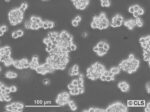| Description |
AR42J cells were derived from malignant nodules in rats’ pancreas induced with azaserine, resulting in tumour formation. Unlike normal acinar cells, AR42J cells exhibit distinct characteristics that differentiate them in several ways. Firstly, they display rapid proliferation, allowing for efficient cell culture and replication. Secondly, their exocrine function regulation is abnormal due to atypical receptors, such as cholecystokinin octapeptide type B and pituitary adenylate cyclase-activating polypeptide type I receptors. This abnormal regulation affects inositol phosphate metabolism and causes disorganization of the cytoskeleton. AR42J cells also possess a unique neuroendocrine-regulated pathway, which involves voltage-sensitive ionic currents, post-translational processing of peptidic prohormones, and the release of small neurotransmitters such as gamma-aminobutyric acid, glycine, and glutamic acid. This pathway indicates the presence of neuroendocrine characteristics in these cells, further distinguishing them from normal acinar cells. These amacrine cells can be seen as a cancerous version of the primordial pancreatic ductular epithelium, as they exhibit characteristics of both exocrine and neuroendocrine cells. When treated with dexamethasone, AR42J cells undergo differentiation towards the exocrine phenotype, further highlighting their ability to adapt and respond to external factors. In terms of their growth and proliferation, AR42J cells show a preference for specific signalling pathways. Occupancy of receptor tyrosine kinases, adenosine 3′,5′-cyclic monophosphate, ornithine decarboxylase expression, and Na(+)-H+ exchange is factors that contribute to the mitogenic pathway of these cells, promoting their growth and division. On the other hand, somatostatin, a hormone that regulates various physiological processes, opposes the proliferation of AR42J cells through protein phosphatases. This inhibitory effect helps to maintain cellular homeostasis and prevent excessive cell growth. Given their unique characteristics and biological behaviour, AR42J cells are valuable for studying various pancreatic biology and cancer research aspects. They serve as a helpful model for investigating the underlying mechanisms of pancreatic tumours and exploring potential therapeutic approaches. Additionally, these cells are commonly utilized in 3D cell culture systems, enabling researchers to study cell behaviour and interactions within a more physiologically relevant environment. Overall, the AR42J cell line offers a powerful tool for advancing our understanding of pancreatic diseases and developing novel treatments. |








Rating & Review
There are no reviews yet.